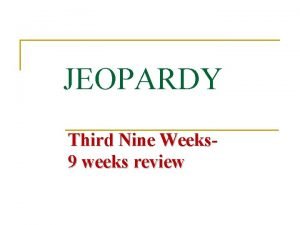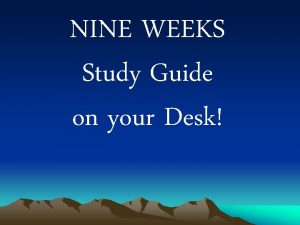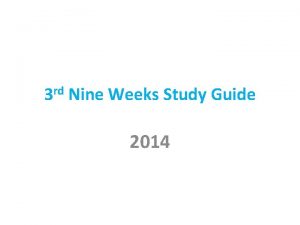1 st Nine Weeks Study Guide Name Draw






- Slides: 6

1 st Nine Weeks Study Guide Name ___________ Draw and label the Equator and the 6 other major lines of latitude. Draw and label the Prime Meridian. 1. What do we call the imaginary lines that measure the distance a place is east or west of the Prim 2. What imaginary lines divides the Earth into northern and southern halves? 3. Which term do we use to describe the exact place on earth at which a geographic feature is fou 4. What does latitude measure? 5. Why are satellites useful to geographers? Give some examples of what satellites can show us. 6. What is a mental map, and what are some uses for a mental map? 7. What is relative location? 8. Where do we find the following? Tornadoes Monsoons - Hurricanes. Typhoons –

9. The natural vegetation in areas nearest to the Equator consists of(what type? ) why? 10. Why do the countries of Western Europe have a mild marine climate? (think ocean currents…) 11. What causes erosion? (Name all the forces…) 12. Besides looking really cool… what is beneficial about volcanoes? 13. How do we categorize the desert climate zone? (What makes a desert? ) 14. Sketch the orographic form of precipitation. Explain the leeward side of mountain and how it dif windward side. 15. Which of the following is caused by human activity? lightning, oil spills, volcanic eruption, or tectonic activity 16. Describe the relationship between latitude and temperature: (ex: at 0°latitude, what is your tem going to be like? )

= _________ Use pages 22 -33 your textbook and your notes to complete the map projections review below: Goode’s _____ Equal- Area Projection _______ projection Used for _________. Why are all maps distorted? Which aspects of the earth are distorted on maps? _______ projection Used for ____________.

Parts of Maps Label the parts of the map below: Which part of the map explains the symbols used on a map? ________ Which part of the map shows the approximate distance between two places? ________ Which part of the map is used to show absolute location? __________ Which part of the map is used to show orientation? ___________ Types of Maps ______ map. Shows areas such as countries, states, and cities. ______ map. Shows features such as lakes, rivers, mountains, relief, and ______ map. Gives specific data or information on a single topic. What does this map show? _________

Label the diagram below using the word bank provided. Beside each climate zone write down if it is warm, cold, or seasonal. Equator Arctic Circle South Pole Tropic of Capricorn North Pole Tropic of Cancer Antarctic Circle High Latitude climates (2) Low Latitude climates(the tropics) Middle latitude climates (2) Use your notes to complete the chart below: Low Latitude Climates Mid Latitude Climates High Latitude Climates Anywhere Climates 1. 1. 2. 2. 3. 3. 4. Name the five factors that influence a region’s climate ( star that is MOST SIGNIFICANT): • • • the one

Use the following word bank to fill in the blanks: botanist erosion satellite GIS census leeward alter remote sensing device windward 1. ________ to change, or make different. 2. ________ a biologist specializing in the study of plants 3. ________ a periodic count of the population. 4. ________ a man-made device orbiting the earth, used in communications or to collect scientific data. 5. ________ the direction from which the wind blows. 6. ________ on or toward the side which the wind blows. 7. ________ the wearing away of rocks or soil by the action of water, ice. or wind. 8. ________ A computer application used to store, view, and analyze geographical information. 9. ________ is the acquisition of information of an object or phenomenon, . by the use of either recording or real-time sensing device(s) that is not in physical or intimate contact with the object (such as by way of aircraft, spacecraft, satellite, buoy, or ship). Draw a line to the correct match: Monsoons Tornadoes Hurricanes Typhoons United States South & Southeast Asia Pacific Ocean Atlantic Ocean True/False 1. ______ Volcanoes can benefit humans. by depositing ash that contributes to fertile soil in the region. 2. _______ The leeward side of the mountain is much drier than the windward side. 3. _______ People are unable to adapt to their physical environment. 4. _______ Vegetation is an element that causes regional climate patterns. 5. _______ Ocean currents redistribute heat from one area of the ocean to another. 6. _______ Most places near the Prime Meridian have a warm climate. 7. _______ Population is the factor that most strongly affects a region’s climate. 8. _______ Maps are more accurate than globes.











